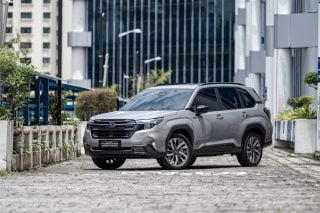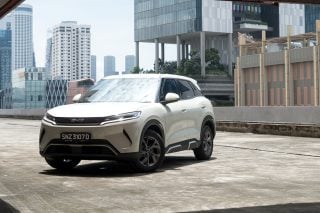If hearing the terms ‘base model’ or ‘entry level’ turn you off, you’re probably recalling how the basic variants of any model family car used to have sparse equipment and miserly performance, especially if it’s from a brand known for advanced technology and superlative performance.
While such instances were more common in decades past, this is no longer true today. Buyers here expect new cars to have high levels of standard kit, especially after paying so much for the privilege of ownership. And if the model in question is a Porsche Panamera, expectations go through the roof.

SEEING DOUBLE
Styling is subjective, but there’s no getting around how similar the latest Panamera looks to the previous one. Viewed from a distance, you’d be forgiven for doubting that this is the all-new one.
Only as you draw closer will you notice that despite their similar silhouettes, the new Panamera is literally sharper than its predecessor. Gone is the roundedness of the previous model – the current one features squared-off bumper edges and prominent bonnet lines.
Even the head lights are more angular. Porsche has also given the Panamera an ‘additional’ air intake slat above the bumper. And to further emphasise the car’s angular styling, the daytime running lights are now vertical instead of horizontal.

It’s harder to spot the changes in the rear, although the eagle-eyed will notice that the taillights are now in a uniform size. In the older model, the taillight section had a ‘cut out’ above the ‘Panamera’ badge.
Get behind the wheel and you’ll find that the cockpit is totally digitised, for the much-loved analogue tachometer has been retired. It may seem unimportant, but somehow, this feature is a link to Porsches of the past, and its deletion is hurtful. Progress has a price.

Nevertheless, the switch to a 12.6-inch curved digital instrument cluster means the driver can now swap between the various layouts and customise the pertinent information he or she wishes to display.
Gone, too, is the conventional gearshift lever previously found on the centre console – it is now an uninteresting toggle on the dashboard to the left of the steering wheel. In its place is a storage compartment, charging pad and USB-C ports.

The physical climate controls have been retained, although these are now haptic. The one feature sure to divide opinions, though, are the digitally adjustable air-con vents. There is no purpose in innovating a solution to a problem that never existed, for adjusting air flows the old-fashioned way is quicker and simpler.
That said, the Porsche Communication Management (PCM) is relatively intuitive, as the menus do not go too ‘deep’. Within minutes, I had tweaked the ambient lighting, adjusted the climate, and dialled in my preferred drive settings.

PROPERLY SPECIFIED
There’s nothing bare about the Panamera, with standard kit including four-zone climate control, powered 14-way Comfort seats, and Surround View with Active Parking Support. There’s also a Bose audio system and soft-closing doors.
This test unit, however, has been upgraded with over $100,000 worth of optional accessories. These include the 21-inch SportDesign wheels ($15,392), Head-Up Display ($7,696), individual comfort rear seats ($13,009), and two-tone leather interior ($24,482).
Other optional goodies here are the Panoramic Roof System ($9,090) and Sport Chrono Package ($12,055). The latter unlocks the Sport Plus setting for the engine, gearbox and suspension, and adds the Sport Response button, which helps hasten overtaking.

That might be overkill in the local context, though, with the turbocharged 2.9-litre V6 putting out 349bhp and 500Nm of torque to enable the Panamera to sprint from rest to 100km/h in 5.3 seconds. Not bad for a 1,960kg fastback.
That said, the car is at its most responsive with the powertrain in Sport Plus, while the dampers remain set to Sport, so the ride remains pliant. Supple might be an even better description, since the Panamera comes standard with two-chamber air suspension.

Has Porsche made the Panamera handle even better? Yes. The previous model needed to be driven quick before you felt it ‘shrinking’ around you. Here, it happens as you make your way to the carpark exit. The older model also needed rear-axle steering to improve manoeuvrability.
The latest Panamera, on the other hand, feels agile from the start.
You don’t expect this limo to behave like a 911, but it is nimble for its size. Point the nose towards the line you wish the Panamera to take, and it willingly follows through. There’s some understeer, but it’s only enough to remind the driver that this is not a hot hatch.
The Panamera has more of a flowing nature than its predecessor, which again, was better off having rear-axle steering to help it ‘shrink’ around the pilot. This comes naturally to the new model – it really feels more instinctive than before.

Could it be better, though? Sure, I wouldn’t mind even quicker gear changes from the 8-speed PDK (dual-clutch) gearbox in the Sport Plus setting. A sports exhaust emitting rorty notes would be nice, too, since the soundtrack is muted till you see 5,000rpm on the rev counter. The car doesn’t need to be quicker, but I’d like it to sound more enticing.
The steering isn’t bad either, for despite the large wheels, there’s still decent feedback from the helm. As for the Panamera’s mass, this is only obvious under hard braking. The engineers have done a heck of a job making this fastback feel smaller and lighter than it is.

IT’S “THE LIMO”
If you’re a keen driver seeking a flagship limo with plenty of verve, the Panamera is, in many ways, an ideal option. Look at the 3.0-litre rivals: The Audi A8 and BMW 735i are less powerful, and while the Mercedes-Benz S450L is surprisingly quicker, all three are comfort-biased.
The Panamera, then, is clearly the driver’s favourite. It has enough poke and is fast enough for local roads and handles bends with ease. Yet its athleticism does not come at a cost to its refinement, for this fastback also feels upmarket (as it should).
The Panamera brings up another point for consideration: Given its performance and standard equipment, is it still considered “entry-level”? Well, perhaps in the context of it being the least powerful model in the lineup, yes. But it exceeds lofty expectations. If that’s not enough to make a “base model” compelling, what is?
Porsche Panamera 2.9 (A)
ENGINE 2894cc, 24-valves, V6, turbocharged
MAX POWER 349hp at 6800rpm
MAX TORQUE 500Nm at 1900rpm
POWER TO WEIGHT 178.1hp per tonne
GEARBOX 8-speed dual-clutch with manual select
0-100KM/H 5.3 seconds
TOP SPEED 272km/h
CONSUMPTION 10.5km/L (combined)
PRICE EXCL. COE From $498,468
AGENT Porsche Singapore
Audi RS7 Sportback review: Part-limousine, part-cruise missile

















































